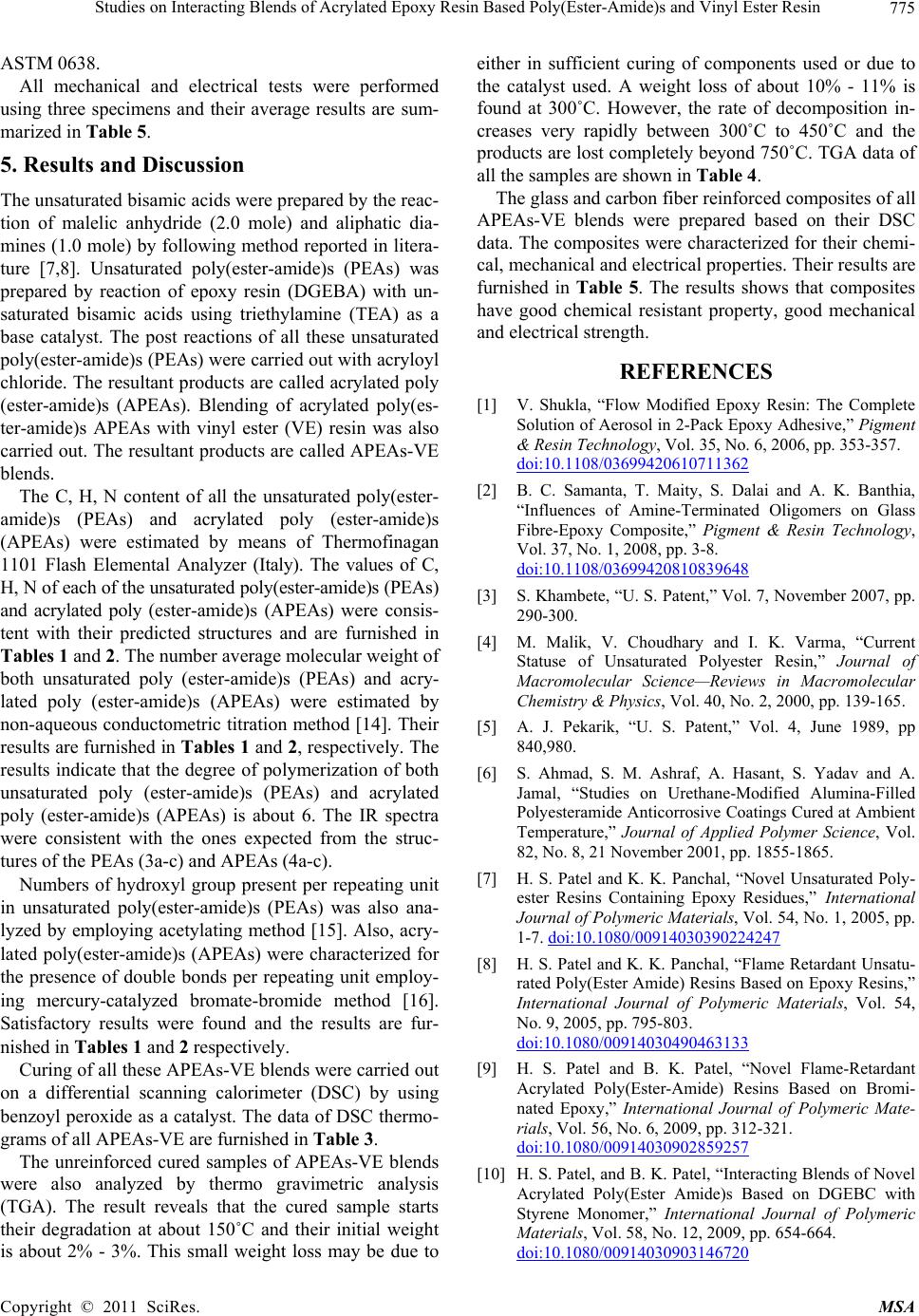
Studies on Interacting Blends of Acrylated Epoxy Resin Based Poly(Ester-Amide)s and Vinyl Ester Resin 775
ASTM 0638.
All mechanical and electrical tests were performed
using three specimens and their average results are sum-
marized in Table 5.
5. Results and Discussion
The unsaturated bisamic acids were prepared by the reac-
tion of malelic anhydride (2.0 mole) and aliphatic dia-
mines (1.0 mole) by following method reported in litera-
ture [7,8]. Unsaturated poly(ester-amide)s (PEAs) was
prepared by reaction of epoxy resin (DGEBA) with un-
saturated bisamic acids using triethylamine (TEA) as a
base catalyst. The post reactions of all these unsaturated
poly(ester-amide)s (PEAs) were carried out with acryloyl
chloride. The resultant products are called acrylated poly
(ester-amide)s (APEAs). Blending of acrylated poly(es-
ter-amide)s APEAs with vinyl ester (VE) resin was also
carried out. The resultant products are called APEAs-VE
blends.
The C, H, N content of all the unsaturated poly(ester-
amide)s (PEAs) and acrylated poly (ester-amide)s
(APEAs) were estimated by means of Thermofinagan
1101 Flash Elemental Analyzer (Italy). The values of C,
H, N of each of the unsaturated poly(ester-amide)s (PEAs)
and acrylated poly (ester-amide)s (APEAs) were consis-
tent with their predicted structures and are furnished in
Tables 1 and 2. The number average molecular weight of
both unsaturated poly (ester-amide)s (PEAs) and acry-
lated poly (ester-amide)s (APEAs) were estimated by
non-aqueous conductometric titration method [14]. Their
results are furnished in Tables 1 and 2, respectively. The
results indicate that the degree of polymerization of both
unsaturated poly (ester-amide)s (PEAs) and acrylated
poly (ester-amide)s (APEAs) is about 6. The IR spectra
were consistent with the ones expected from the struc-
tures of the PEAs (3a-c) and APEAs (4a-c).
Numbers of hydroxyl group present per repeating unit
in unsaturated poly(ester-amide)s (PEAs) was also ana-
lyzed by employing acetylating method [15]. Also, acry-
lated poly(ester-amide)s (APEAs) were characterized for
the presence of double bonds per repeating unit employ-
ing mercury-catalyzed bromate-bromide method [16].
Satisfactory results were found and the results are fur-
nished in Tables 1 and 2 respectively.
Curing of all these APEAs-VE blends were carried out
on a differential scanning calorimeter (DSC) by using
benzoyl peroxide as a catalyst. The data of DSC thermo-
grams of all APEAs-VE are furnished in Table 3.
The unreinforced cured samples of APEAs-VE blends
were also analyzed by thermo gravimetric analysis
(TGA). The result reveals that the cured sample starts
their degradation at about 150˚C and their initial weight
is about 2% - 3%. This small weight loss may be due to
either in sufficient curing of components used or due to
the catalyst used. A weight loss of about 10% - 11% is
found at 300˚C. However, the rate of decomposition in-
creases very rapidly between 300˚C to 450˚C and the
products are lost completely beyond 750˚C. TGA data of
all the samples are shown in Table 4.
The glass and carbon fiber reinforced composites of all
APEAs-VE blends were prepared based on their DSC
data. The composites were characterized for their chemi-
cal, mechanical and electrical properties. Their results are
furnished in Table 5. The results shows that composites
have good chemical resistant property, good mechanical
and electrical strength.
REFERENCES
[1] V. Shukla, “Flow Modified Epoxy Resin: The Complete
Solution of Aerosol in 2-Pack Epoxy Adhesive,” Pigment
& Resin Technology, Vol. 35, No. 6, 2006, pp. 353-357.
doi:10.1108/03699420610711362
[2] B. C. Samanta, T. Maity, S. Dalai and A. K. Banthia,
“Influences of Amine-Terminated Oligomers on Glass
Fibre-Epoxy Composite,” Pigment & Resin Technology,
Vol. 37, No. 1, 2008, pp. 3-8.
doi:10.1108/03699420810839648
[3] S. Khambete, “U. S. Patent,” Vol. 7, November 2007, pp.
290-300.
[4] M. Malik, V. Choudhary and I. K. Varma, “Current
Statuse of Unsaturated Polyester Resin,” Journal of
Macromolecular Science—Reviews in Macromolecular
Chemistry & Physics, Vol. 40, No. 2, 2000, pp. 139-165.
[5] A. J. Pekarik, “U. S. Patent,” Vol. 4, June 1989, pp
840,980.
[6] S. Ahmad, S. M. Ashraf, A. Hasant, S. Yadav and A.
Jamal, “Studies on Urethane-Modified Alumina-Filled
Polyesteramide Anticorrosive Coatings Cured at Ambient
Temperature,” Journal of Applied Polymer Science, Vol.
82, No. 8, 21 November 2001, pp. 1855-1865.
[7] H. S. Patel and K. K. Panchal, “Novel Unsaturated Poly-
ester Resins Containing Epoxy Residues,”International
Journal of Polymeric Materials, Vol. 54, No. 1, 2005, pp.
1-7. doi:10.1080/00914030390224247
[8] H. S. Patel and K. K. Panchal, “Flame Retardant Unsatu-
rated Poly(Ester Amide) Resins Based on Epoxy Resins,”
International Journal of Polymeric Materials, Vol. 54,
No. 9, 2005, pp. 795-803.
doi:10.1080/00914030490463133
[9] H. S. Patel and B. K. Patel, “Novel Flame-Retardant
Acrylated Poly(Ester-Amide) Resins Based on Bromi-
nated Epoxy,” International Journal of Polymeric Mate-
rials, Vol. 56, No. 6, 2009, pp. 312-321.
doi:10.1080/00914030902859257
[10] H. S. Patel, and B. K. Patel, “Interacting Blends of Novel
Acrylated Poly(Ester Amide)s Based on DGEBC with
Styrene Monomer,” International Journal of Polymeric
Materials, Vol. 58, No. 12, 2009, pp. 654-664.
doi:10.1080/00914030903146720
Copyright © 2011 SciRes. MSA